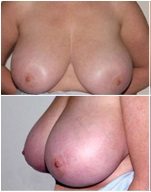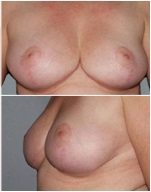

Overview
Very large breasts can seriously affect lifestyle and daily activities – causing neck ache, upper back pain and dragging discomfort on the front of the chest, while bra straps can create deep grooves in the shoulders. Likewise, heat rashes, known as intertrigo, can develop beneath large, pendulous breasts.
Seeing the transformation in a woman’s life that a skillfully performed breast reduction produces is always a joy for everyone involved. The weight loss and reduction in size and discomfort in the breasts allows for a change in lifestyle from sedentary to active. This means further weight loss is often possible once regular exercise becomes possible and enjoyable.
The weight of tissue removed from both breasts may range anywhere from 300-2500 gms. Some health insurance policies cover a portion of the costs for this plastic surgery.
There are several main types of breast reduction depending on the volume of the reduction required. The most commonly used keeps a central ‘mound’ of breast tissue with the nipple attached at its apex. The remaining surplus gland and breast tissue are trimmed away until the desired size is obtained, and the skin is ‘tailored’ and trimmed to fit. The resulting ‘seams’ or incisions/suture lines are around the outside of the nipple/areola area, vertically below to the crease under the breast, and also a variable transverse incision in this crease, which is called the inframammary fold. This technique is commonly used for DD cup breasts and bigger.
Simpler procedures with shorter ‘seams’ or scars are done for C-D cup breasts. A different approach, which involves nipple grafting, is used for extremely large breasts.
Every breast reduction is individually planned to accomplish the desired result. What type of procedure would be right for you, how long it would take and the likely cost can only be determined after consultation with, and examination by one of our surgeons. During the consultation, you will also be shown pre and post-operative photographs of similar procedures so that you can see the results and the quality of our work. You will be given reading material describing the procedure to take away with you so that you will feel fully informed before making your decision about surgery.
Best Candidates
Breasts that are too large in proportion to their body frame
Back, neck and/or shoulder pain aggravated by the weight of the breasts
Indentions (grooving) in their shoulders from tight bra straps
Restriction of physical activity due to the size and weight of the breasts
What to Expect
During breast reduction surgery, liposuction is often a part of the process. It is important to maintain a good blood supply to the nipple areola complex as there is a risk of discolouration and loss of sensation when blood flow is restricted. Our doctors are very careful to ensure that this risk is minimized as much as possible. We will remove the extra loose skin and tighten the underlying tissue to form the newly shaped breasts. During surgery, we may use one of the following incision patterns depending on the breast reduction technique employed:
One around the areola.
One vertically from the bottom edge of the areola to the breast crease.
One horizontally in the breast crease.
Previous Results


After Surgery / Recovery
After breast reduction surgery, patients will immediately feel lighter on top. The amount of breast tissue removed during surgery will be based on the initial evaluation and the patient’s preference. Often, the reduction results in a cup or two smaller from the original breast size. For the first several weeks, our doctor will recommend the use of a compression bra to protect the breasts. Patients may go back to work within 7-10 days and may resume physical activities (such as exercise) between 6-8 weeks post-operative. Nipple sensitivity will return gradually within the first year.
Swelling and bruising can be assisted by applications of ice, remember to wrap the ice in several towels, not applying it directly to the skin or you may produce an ice burn. There may be a temporary loss of sensation around the breasts and on the nipples due to trauma to the local nerves. This usually settles in two to three month, however, may persist longer.
Do not be afraid to ask questions or to let the staff or your Surgeon know of any specific problems or worries that you may have. After drain removal, dressing check and bra fitting your progress will be followed up on a regular basis by our Nursing staff.


